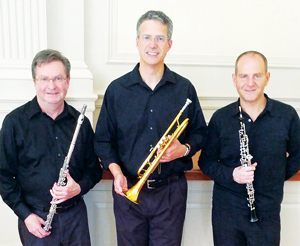by J.D. Goddard

Woods opened the program with Edward Elgar’s Introduction and Allegro, op. 47 for solo string quartet and strings, showcasing Blue Water violinists Kenneth Johnston and Emily Cornelius, violist Laura Shuster, and cellist Kent Collier.
The opening statement from the strings immediately grabbed one’s attention with its dramatic clarity before melting into magnificent sonorities that played the quartet off against the full string compliment. Rallentandos, rubatos and ritards were abundant and splendidly romantic in style.
The rather challenging but brief fugue was delightfully tossed off between the musicians. The lower strings laid down a solid foundation upon which the upper strings and quartet joyously conducted their virtuosic meanderings. Johnston, Cornelius, Shuster and Collier demonstrated the brilliance and professionalism that has become a trademark of Blue Water’s performances.
Second on the program was Samuel Barber’s hauntingly eloquent Adagio for Strings, which began life as the second movement of his opus 11 string quartet. At the urging of Arturo Toscanini, Barber (at age 26) orchestrated the Adagio for string orchestra, the form in which the music is most often heard today.
Barber’s Adagio reaches deeply into one’s heart and soul, leaving a feeling of peace and reconciliation. Blue Water’s attention to subtlety and gradation made for an exceptional interpretation and a soothing contrast to the Elgar.
Barber’s Capricorn Concerto, op. 21 was named for the home he shared with Gian Carlo Menotti in Mount Kisco, New York and features the same three solo instruments as J.S. Bach’s second Brandenburg concerto.
The first movement is bit atonal and seems to lack musical cohesion. The second movement jumps about with much imitation and echoing of thematic materials while pairing the oboe and muted trumpet in a brief but interesting moment. The third movement features a trumpet fanfare, an homage to Bach. Gabriel, Mueller and Neubert all performed with absolute precision and attention to detail but had very little promising material with which to work.
Last on the program was Tchaikovsky’s Serenade for Strings, op. 48. The stirring 36-bar introduction is restated at the end of the movement, then reappears, transformed, in the coda of the fourth movement, tieing the entire work together. The second movement waltz has become a stand-alone work for many orchestras. The third movement, Elegie, was elegantly played with acute attention to rallentandos and rubatos. Laura Shuster’s resonant viola solo was among the musical highlights of the evening. The Finale (Andante) was gently laid out with precision and warmth followed by an Allegro con spirito that flew like the wind.
The Serenade was a fitting conclusion to an excellent evening of music. The strings were strong and played with ease and confidence and both string and wind soloists were outstanding. Carlton Woods maintained steady control of the group while repecting the nuances of each composer’s style. Blue Water continues to make its mark on Cleveland’s musical landscape.
Published on ClevelandClassical.com March 4, 2014
Click here for a printable version of this article.



